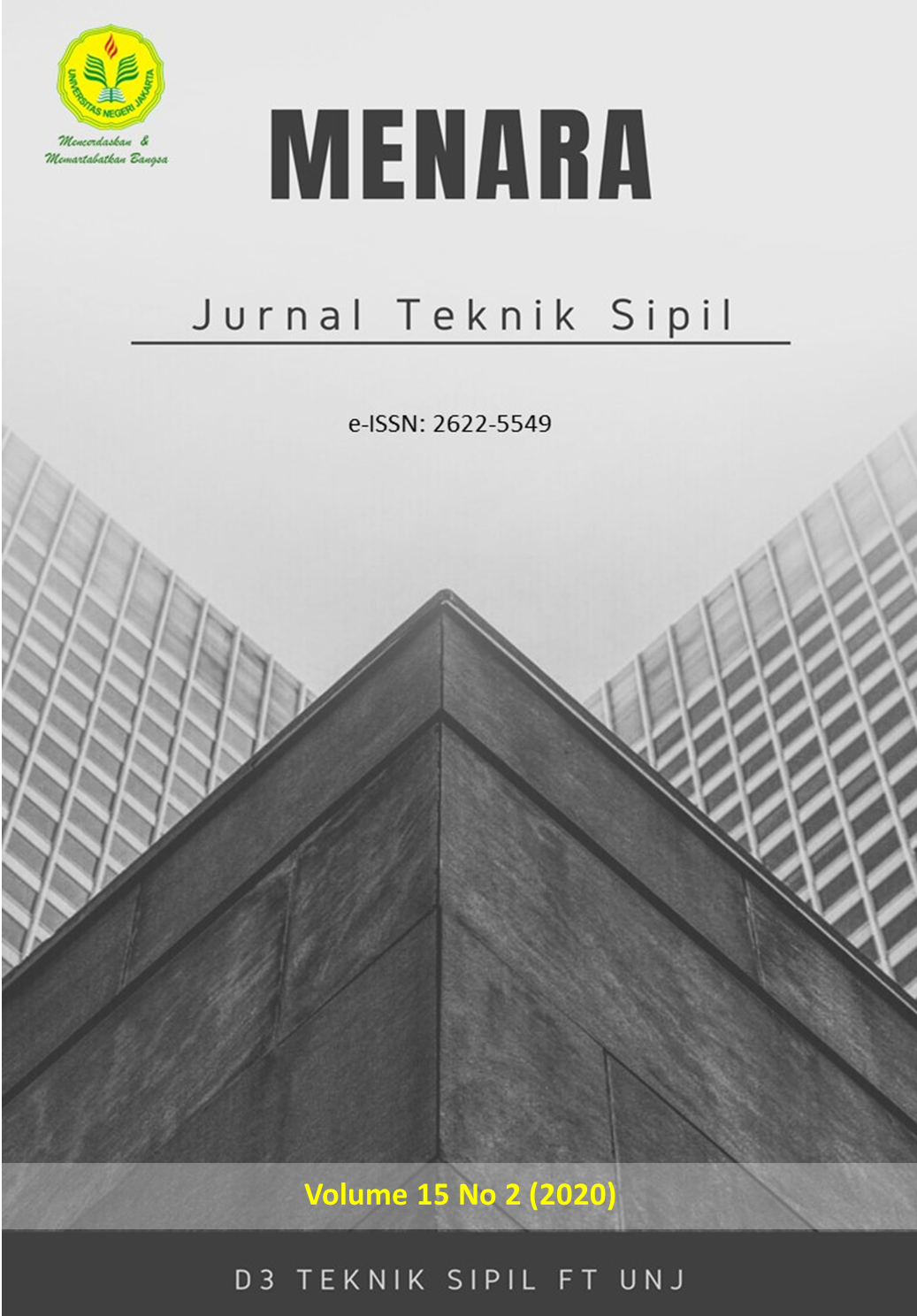PEMANFAATAN LIMBAH KOTORAN SAPI SEBAGAI PENGGANTI SEBAGIAN SEMEN DALAM PEMBUATAN BATAKO
DOI:
https://doi.org/10.21009/jmenara.v15i2.14214Keywords:
cow manure waste, batako, strong press, water absorptionAbstract
The results showed the use of cow dung waste can increase the compressive strength of hollow brick from any composition of waste. Hollow brick with cow dung substitution of 0% has an average compressive strength value 44.75 Kg/Cm2 has an average water absorption of 14.31%, hollow brick with cow dung substitution of 5% has a value of compressive strength average 47.47 Kg/Cm2 has an average water absorption of 15.67%, Batako perforation with cow dung substitution of 7.5% has an average compressive strength value of 51.83 Kg/Cm2 has the absorption water averaging 13.71%, batako perforated with substitution of cow dung waste of 10% has an average compressive strength value 53.81 Kg/Cm2 has an average water absorption of 10.04%, hollow brick with substitution cow dung waste of 12.5% has an average compressive strength value of 50.66 Kg/Cm2 has an average water absorption of 23.6%, hollow brick with cow dung substitution of 15% average 48.84 Kg/Cm2 has an average water absorption of 19.72%. The optimum compressive strength value was obtained from percentage substitution of cow dung waste at 10% with mean value of compressive strength 53,81 Kg/Cm2 with average water absorption 10,04%.
References
Aprina, H. P. 2012. “Analisis Komposisi Asam Amino Gelatin Sapi dan Gelatin Babi pada Marshmallow Menggunakan Teknik Kombinasi HPLC dan PCA”.
Bintang, M. 1999. “Aspek Biokimiawi Bakteri Asam Laktat Selain Sebagai Bibit Keju dan Yogurt”. Orasi Ilmiah, FMIPA: IPB.
Departemen Kesehatan RI. 2009. “Sistem Kesehatan Nasional”. Jakarta.
Hastuti, L. 2015. “Pengujian Kualitas Bahan Baku dalam Pembuatan Susu Pasteurisasi dan Homegenisasi”. CV Cita Nasional.
Kurniawan, K., Lestari, S., & RJ, S. H. 2012. “Hidrolisis Protein Tinta Cumi-Cumi (Loligo sp.) dengan Enzim Papain”. Jurnal Fishtech, 1(1), 41-54.
Nofrianti, R., Azima, F., & Eliyasmi, R. (2013). Pengaruh Penambahan Madu terhadap Mutu Yoghurt Jagung (Zea mays Indurata). Jurnal Aplikasi Teknologi Pangan, 2(2).
Rafika, M., & Anjani, G. “2016”. Karakteristik Fisik dan Organoleptik Yoghurt Susu Jagung dengan Penambahan Besi dan Vitamin A (Disertasi Doktoral, Universitas Diponegoro).
Rediatning, S. W., & Kartini, H. N. 1987. “Analisis asam amino dengan Kromatografi Cairan Kinerja Tinggi secara Derivatisasi Prakolom dan Pascakolom”. Proceedings ITB, 20(1/2), 41-59.
Sukarni. 2013. “Pembuatan Yoghurt dari Susu Jagung Manis (Zea mays L.) sebagai Minuman Prebiotik yang Baik bagi Penderita Diabetes dan Obesitas”. Journal Cyber-Techn, 8(1), 1–13.
Sukardi, Pulungan, MH, & Purwaningsih, I. 2001. “Optimasi Penambahan Sari Kecambah Jagung Guna Meningkatkan Kualitas dan Rasa Soyghurt untuk Diet Jantung Koroner”. Journal Teknologi Pertanian, 2(2), 38-51.
Yasni, S., & Maulidya, A. 2014. “Development of Corn Milk Yoghurt Using Mixed Culture of Lactobacillus delbruekii, Streptococcus salivarus, and Lactobacillus casei. HAYATI Journal of Biosciences, 21(1), 1-7.
Downloads
Published
Issue
Section
License
Authors who publish with this Journal agree to the following terms:
- Author retain copyright and grant the journal right of first publication with the work simultaneously licensed under a creative commons attribution licensethat allow others to share the work within an acknowledgement of the work’s authorship and initial publication of this journal.
- Authors are able to enter into separate, additional contractual arrangementfor the non-exclusive distribution of the journal’s published version of the work (e.g. acknowledgement of its initial publication in this journal).
- Authors are permitted and encouraged to post their work online(e.g. in institutional repositories or on their websites) prior to and during the submission process, as it can lead to productive exchanges, as well as earlier and greater citation of published works.











